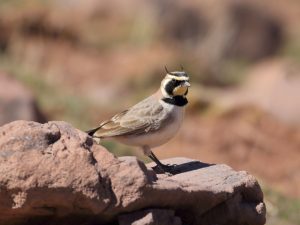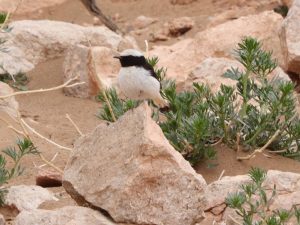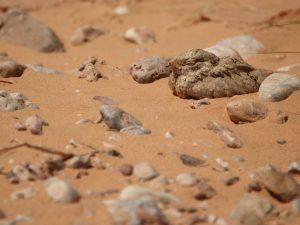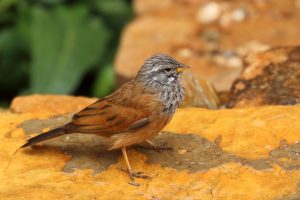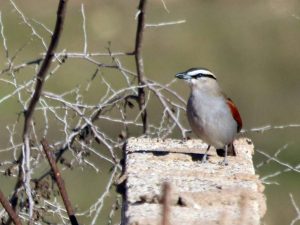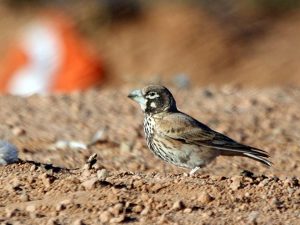
easy birding and natural history
A birding exploration of the varied habitats of southern Morocco.
Download leaflet
Dates
To be confirmed
Leaders
To be confirmed
Price
To be confirmed
Included
Return flight from London Gatwick. Local transport as specified in itinerary. Twelve nights accommodation, full board.
Not included
Refreshments. Gratuities. Travel insurance. Covid tests and associated costs.
Group size
Minimum 4, maximum 12.
March is a very pleasant time to visit Morocco, with good weather, large numbers of migrating birds heading northwards to Europe and plenty of plants in flower, both on the coast and in the mountains.
We will start our tour on the Atlantic Coast, seeking out local specialties, including House Bunting, Moussier’s Redstart, Black-crowned Tchagra and, with luck, the Endangered Northern Bald Ibis. We will visit the Sous Massa National Park where, as well as a variety of birds, we will also look for several species of antelope that have been reintroduced here, including Addax, Dorcas Gazelle and the graceful Scimitar-horned Oryx.
Heading inland we will pass through the Argan forest of the Sous Valley to the arid rocky steppe of the Tagdildt Track, home to various larks and wheatears, Cream-coloured Courser and Fat Sand Rat.
We will explore rock gorges in search of Pharoah Eagle Owl, Maghreb Wheatear and the endearing Gundi, before reaching the stony desert of the Tafilalt and the magnificent sand dunes of Erg Chebbi, home to some true desert specialities including Desert Sparrow, African Desert Warbler, Fulvous Babbler and Egyptian Nightjar.
Finally, we will head up to the High Atlas, near the snow line, where we will look for Levaillant’s Woodpecker, Seebohm’s Wheatear, African Crimson-winged Finches and Atlas Horned Lark.
Along the way, we will pass through some spectacular landscapes, stay in comfortable local hotels, and enjoy some wonderful food and hospitality.
Please note that holidays change, although sometimes only slightly, from year to year and previous trip reports may not reflect the planned itinerary, or other holiday details, for the current trip. Please ask us if you would like to know of any significant differences.
Day 1 Fly to Agadir and transfer to Atlas Kasbah.
Day 2 This morning we head to the Atlantic coast, where we hope to see the Endangered Northern Bald Ibis. This coastline is also well known for its unique communities of succulent Euphorbias, and we will stop to explore this interesting habitat, hoping to find Moussier’s Redstart, Spectacled Warbler and Black Wheatear along with endemic geckos and interesting plants.
Day 3 We head to the famous Sous Massa National Park to learn about the important conservation work going on here; ’rewilding’ of a variety of Saharan antelopes including Dorcas Gazelle, Scimitar horned Oryx and Addax, and the Red-necked Ostrich, all of which have become extinct across much of their range. We visit the reintroduction area, enjoying close encounters along the way. We spend the afternoon at Oued Massa, hoping to hear the fluting song of Black crowned Tchagra.
Day 4 We start today with a visit to the river mouth at Oued Sous, where flamingos gather on the estuary and feed alongside various waders, gulls and terns. From here we strike inland, travelling through the famous argan forests of the Sous valley, towards Oulad Berhil, where we spend the night.
Day 5 We continue our journey eastwards, travelling through increasingly arid, rocky landscapes as we head towards Ouarzazate. Along the way we will start to see White-crowned and Desert Wheatears and a variety of larks along the roadside, and keep our eyes open for Barbary Falcon, Lanner and Long-legged Buzzard.
Day 6 Our morning starts with a visit to the nearby Ouarzazate Reservoir. Various migrants rest here on their journey northwards, and could include a variety of waders and wildfowl, warblers and wagtails. From here we travel eastwards to Boumalne des Dades where we explore the Tagdildt Track, an area famous for its desert steppe birds: we hope to find a variety of larks along with Red-rumped Wheatear, Cream-coloured Courser and Trumpeter Finch.
Day 7 After the travelling day yesterday, we will spend the day locally, travelling up the Dades Gorge, where birds might include Tristram’s Warbler, Golden Eagle and Rock Bunting. We may return to the Tagdildt Track, depending on our success yesterday, or relax during the afternoon.
Day 8 This morning we continue our journey eastwards. Along the way we will check cliff faces for a chance to find Pharoah Eagle Owl. Nearby we hope to find Maghreb Wheatear. Further eastwards, depending on time available, we may look for Saharan Scrub Warbler before finally arriving in the desert proper of the Tafilalt, at Merzouga.
Days 9/10 We spend two days exploring the Tafilalt taking a four wheel drive ‘safari’ one day in search of some of the special birds of the desert: Egyptian Nightjar, Houbara Bustard and Desert Sparrow, as well as Spotted Sandgrouse, Bar-tailed Desert Lark and African Desert Warbler. We will visit the sand dunes of the Erg Chebbi and explore the oasis gardens in search of migrant birds.
Day 11 Today we head back to Ouarzazate through the Anti Atlas mountains, with one or two stops along the way amongst the stunning scenery.
Day 12 Up until now we have been south of the High Atlas: today we cross the mountains, via the Tiz n Tichka pass at an altitude of 2,260 metres. From these heady heights we drop back down into the plains near Marrakech, before climbing again up towards the ski resort of Oukaimeden.
Day 13 An early start takes us in search of one of the stars of the mountains; African Crimson-winged Finches that feed around the base of the Oukaimeden ski lifts. Atlas Horned Lark and both Alpine and Red-billed Chough should also be found, and we may be lucky and find an early returning Seebohm’s Wheatear. Nearby we will look for Levaillant’s Woodpecker. From here, we head to Marrakech for our flights.
Please note that the itinerary may be changed to suit the weather or other practicalities at the discretion of the leaders.
Our hotels and guesthouses will have en-suite accommodation: dinner and breakfast will be taken in the hotels, with lunches a mixture of picnics and ’sit down’ meals in hotels and local restaurants.
We will travel by minibus. Our excursions in Sous Massa National Park and into the desert beyond Merzouga will be by comfortable four wheel drive vehicles.
Group flights
Group flights are with Easyjet from London Gatwick.
Overland travel
You can reach Morocco by train and ferry from the UK. From London you can reach Marrakech in two nights. Agadir can be reached by bus from Marrakech. Contact us to find out more, and to make your holiday flight-free.
Time zone
Morocco is one hour ahead of UK time.
Entry requirements
If you hold a British passport you can travel to Morocco for up to three months without a visa. Your passport must be valid for at least three months on your date of entry.
In March, the weather is usually sunny but not too hot. If we get hot weather we will adapt the itinerary as much as possible. There may be cooler weather, particularly in the mountains.
This is not a strenuous holiday. The main fitness consideration is likely to be long distances travelled by bus. There will be some walking, including on sand dunes/sandy beaches, and on rocky/uneven tracks, sometimes gently uphill. We will adapt our walking to the weather but we will no doubt be walking in the sun on some days, albeit not for very long walks. The hotel rooms may be on the first or second floor, with no lift available.

